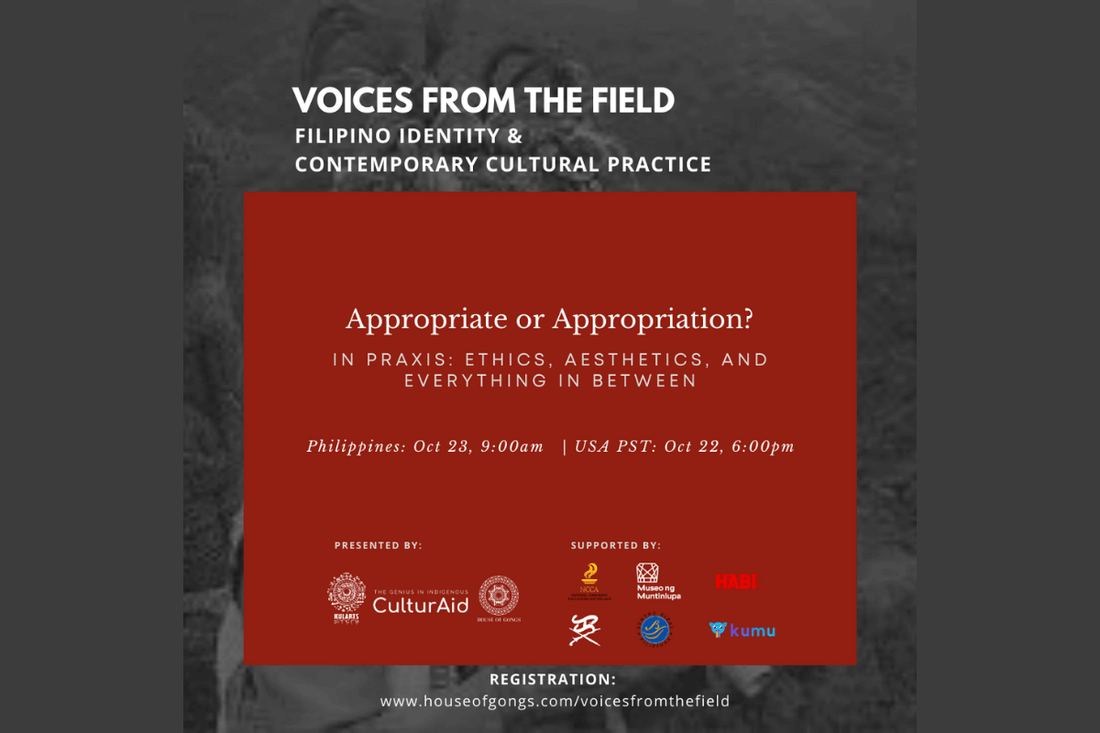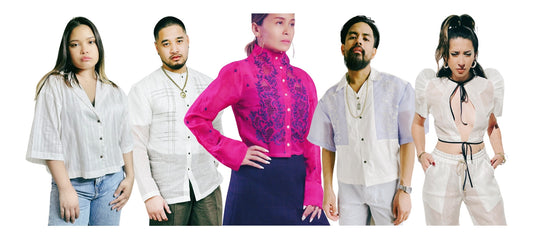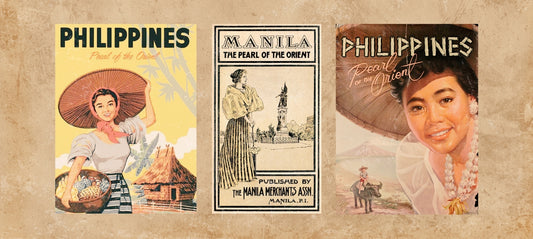It was an international online event unlike any other — that had us yearning for more.
Last week, 18 practitioners, culture bearers, educators, social entrepreneurs, designers and artists from across the Philippines and the diaspora came together to discuss cultural appropriation, as part of the Voices from the Field series, put on by House of Gongs, KulArts and CulturAid. Voices from the Field: Filipino Identity and Contemporary Cultural Practice is a new 3-part online event that was created to help bridge interdisciplinary voices and encourage meaningful dialogue around different topics related to Filipino identity, affirmation, education and contemporary cultural practice.
Over 2,000 viewers on the Kumu Livestream and 150 Zoom participants joined the second session on October 22nd North America time/October 23rd Philippines time entitled, “Appropriate or Appropriation? In Praxis: Ethics, Aesthetics, and everything in between,” in a discussion that lasted close to 4 hours. With an increase in indigenous products and services in the marketplace and social media callouts about cultural appropriation happening left, right and centre, it was a super relevant and hot topic of discussion concerning IP groups and weavers, small Filipino businesses, artists, educators and Filipinx consumers alike.
The speakers discussed indigenous production and consumption in the contemporary setting and its effects on the community, with each panelist sharing their personal journeys, perspectives and resources while interested participants asked questions and shared their thoughts. Each speaker had a different take on what made something “appropriate or appropriation” with a lot of variation on nuance — there was no right or wrong. It was an engaging and interesting learning experience for all involved from start to finish, with one key takeaway: the Philippines and the diaspora is a complex mix of varying cultures with different approaches on how they want their own culture to be shared and experienced.
We’ve gathered a few highlights from this fascinating talk, as well as resources and links to the speakers’ pages for further information.
The session opened with an introduction of all the moderators who helped put the whole series together — Charisse Tugade, cultural anthropologist and founder of CulturAid, Ron Quesada of Kulintronica and Baybayin artist Kristian Kabuay — followed by a performance by Manobo musician and singer, Bayang Barrios, to kick start the event.

The speakers were organized in “batches,” with Salika Samad starting off the session with her personal journey and an introduction to Maranao weaving. She, along with her husband Jardin Samad, founded Maranao Collectibles — a group of internally-displaced women and men who create heirloom langkit weaving in an effort to preserve Maranao culture. Her cultural identity, she says, was on the verge of dying and creating these cultural products not only gave her and her community a sense of pride and joy, but also helped to continue the weaving tradition and appreciation of the langkit.
Along the same vein, Virgie Nicodemus of CulturAid and Manila Collectible shared the importance of cultural spaces that fuse heritage, education and responsible retail, and that help to sustain the practice and relevance of Philippine Indigenous Heritage.
The Manila Collectible Facebook page outlines the organization’s values, which includes a focus on education and sharing knowledge about Philippine prehistory and Philippine indigenous people. One of their main initiatives is also to promote services and items created by the indigenous communities across the Philippines. “By doing this, we provide means for communities to promote, preserve and revitalize their culture while earning a living,” it adds on the Facebook page.
Virgie also went on to discuss cultural appropriation and ethnocentricity, offering a few tips for consumers on how to know if it’s “okay” to shop for certain products.

One of the most important tips, she says, is to do your research and simply be aware. Check in with valuable resources like Manila Collectible who are doing the work of cultural mapping and are in touch directly with IP communities and artisans, and can provide sound advice on the sourcing of certain products.
Josephine “Arjho” Turner of KafyeBlaan Empowerment presented an informative and extensive look at cultural appropriation, as it pertained to her personal experiences and academic work as a Blaan. Her breakdown of cultural appropriation and how it can degrade cultural integrity was an important learning experience, as it offered a foundational checklist for those working with cultural products and indigenous fabrics. She calls us to ask certain questions as entrepreneurs and business owners working on projects that involve Indigenous cultural heritage, being mindful of the cultural wishes of IP groups and finding ways to collaborate directly with them. “Lift them up and make them known,” Arjho says. “Put them in the centre.”
The Zoom chat group was lively during the panel discussions, as participants were able to share their questions and comments throughout the talks. Many people expressed how organized online gatherings like these were long overdue and so much needed. After the first batch of speakers concluded, Soultree C commented, “More roundtables for our diaspora and motherland communities would heal so much of this misinformation and harm.”
The next batch of speakers featured a mix of textile industry advocates, fashion designers and culture bearers from the Philippines and the diaspora, including Adelaida Lim of Habi: The Philippine Textile Council, Lydia Querian of Daily Malong and Gongster’s Paradise, Claire Powers of KINdom, Caroline Mangosing of VINTA Gallery and Margareth Balansi, weaver and Ga’dang culture bearer.
Adelaida Lim, president of Habi: The Philippine Textile Council spoke next, expressing her enthusiasm for the annual trade fair Likhang Habi Market Fair, which went online for the first time this past week due to the pandemic. The fair showcased sustainable and ethical fashion and lifestyle products from over 30 merchants from weaving communities across Luzon, Visayas and Mindanao. As mentioned on the HABI website, “Since 2009, HABI has been providing traditional weavers and local weaving communities platforms to further enhance their skills in creative design and modern marketing by exchanging ideas with consumers, designers, and traders. The Likhang HABI Market Fair allows them to innovate and to level up to modern trends.”

One of the main goals at HABI is to create a renewed interest in traditional textiles and to ensure that traditional textiles from different areas of the country can still be a part of the modern lifestyle. “Everyone has a different take on something, but there’s a special sense that we all belong to the same family,” Adelaida said, during the discussion.
One of the participants from the Zoom group chat graciously summed it up: “Sustainable livelihood for indigenous artists is important AND educating the consumers to be respectful and acknowledge the source. Bringing back humanity in community.” Well said.
Lydia Querian shared her personal journey, moving from the Motherland to the diaspora, and how Daily Malong came about as a way to empower weavers and artists in Indigenous communities in the Philippines. Purchasing through the Daily Malong online store helped to continue the living traditions of IP groups while introducing their handwoven creations to the Filipino diaspora in North America.
Similarly, KINdom’s Claire Powers, who was also born in the Philippines and raised in the U.S, shared her story and background as a former “fast fashion” designer turned sustainable fashion advocate and entrepreneur. In her talk, she highlighted the Sustainable Development Goals (SDGs), a set of 17 global goals developed by the United Nations to help combat climate change and improve the working conditions and economic livelihood of workers in textile and garment factories. She incorporates these goals into KINdom, a slow fashion brand that “combines style, sustainability and indigenous materials from around the globe into pieces that have meaning and purpose.” As Indigenous cultures, she says, are on the brink of dying out, Claire expressed her concern about those who are too quick to call “cultural appropriation” on brands without doing their research or understanding the effects of their actions. Textiles help to sustain Indigenous communities, she adds, and weaving helps support their families. “They’re cancelling their culture through ‘cancel culture,’” Claire says.
Our very own Caroline Mangosing, founder and CEO of VINTA Gallery, spoke next and shared her personal journey in creating the modern Filipiniana brand, touching on the aggressive social media callout campaign against VINTA — which became the catalyst for this particular session. The confusion and rage that was brought about by the callout was grounded in the paradigm of white people versus Indigenous people or white people versus black people, she says — in the Philippines, a country of over 7,600 islands made up of groups of people from vastly different indigenous cultures and languages all colonized into one unified nation, the issue of cultural appropriation is much more complex. (Read more in Caroline’s viral blog post, “A Letter to Filipinxs in the Diaspora.”) She reiterates a well-known quote by Audre Lorde, who stated that “the master’s tools will never dismantle the master’s house” — we cannot apply the same system of oppressions to have a productive dialogue about intercultural challenges within our own community.
Caroline continued the session by sharing her personal story and background of the company, which was a culmination of a 20-year career working to uplift critical Filipino culture through the arts and education — especially those in the diaspora.

Born in the Philippines, her family migrated to Los Angeles, California and then to Vancouver, Canada at a young age. In her adult years, she later moved to Toronto, Canada after realizing almost 50% of Filipinos in the country were based in this thriving city. She founded the Kapisanan Philippine Centre for Arts and Culture in Toronto, a safe, multidisciplinary space for Filipino-Canadian youth that helped activate their creativity, allowed them to explore their cultural identity and empowered them to reach their full potential. As one of the only Filipino-based cultural centres in Toronto, naturally Caroline received calls asking her where they can find barongs, ternos and other Filipino-related garments. VINTA was created within Kapisanan, first as a social enterprise, until years later when it became a for-profit ethical fashion brand — the VINTA Gallery we see today.
She ended her talk by saying, “I’m not a culture bearer; I’m just a regular Filipino immigrant, fashion designer and entrepreneur. I simply want to continue to share my culture.” (Read more about the steps VINTA Gallery is taking as a response to concerns with textile sourcing.)
The list of speakers in this batch continued with Margareth Balansi, Ga’dang culture bearer, urging that government laws are needed to protect and regulate textiles. When in doubt, she says, just ask the right culture bearers or right culture masters. “We won’t hesitate to share our knowledge about how to wear it or use it.”
The discussion went well into the evening for many of those in North American time zones — in UK time, it went until 5 am! More speakers from even more disciplines were introduced, including fashion designer Anthony Cruz Legarda of The Hinabi Project, Leonardo Carino of the contemporary dance company Teatro Ambahanon and T’boli culture bearer, Myrna Pula — all of whom continued to provide us with different perspectives from the Philippines and the diaspora.
Lane Wilcken, a hand tap tattoo practitioner and culture bearer, shared his personal and professional journey in his quest to revive and practice ancestral Filipino hand-tap tattooing as a ritual, and the issues and concerns around modern western tattooing.
“Modern western tattooing is the result of taking indigenous practices and stripping them of their spiritual qualities leaving only the 'art' upon the skin,” he comments on his website. “The recipient is left to make their own meaning for the designs rather than receive sacred ritual marks that are recognized by generations upon generations of ancestors. Let us work to decolonize tattooing and restore its honor."
Ayta Magbukon culture bearer Rebecca Reyes talked about preserving language. A loose translation of what she said: “Our land, ancestors, education… It's sad to see that our language(s) is/are being lost… Us elders come together to design an education program to help children learn from a very young age. We are peace-loving people so we don't say much [about our grievances], but we are very sensitive/feel deeply."
It was an international online event that, as some of the moderators mentioned, could be its own Netflix multi-part series. At the end of the day, Ron Quesada concluded it best — each person and each group will have its own different levels of sensitivity towards the issue of cultural appropriation based on their own personal experiences, learnings and insights. There is no referee to call foul. What is most important is to continue to have global forums like these to discuss, learn, share, educate and grow as a community. We’re all in this together.









